
_______________________
_______________________
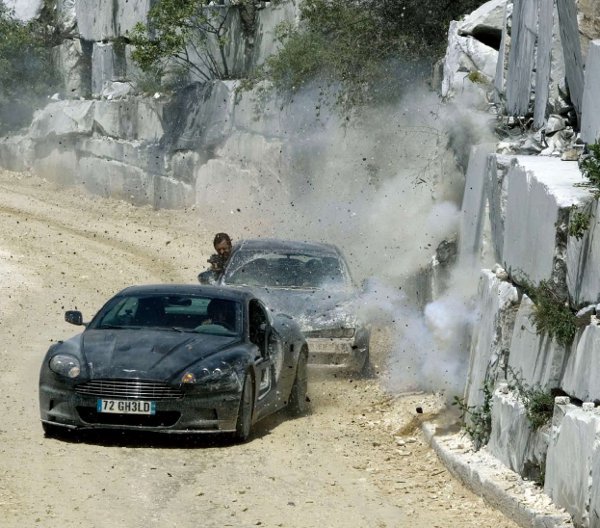
Daniel Craig continues to be a safe driver and I believe he took out accidental damage insurance in case of a dent or scratch.
BOND ON CARS
As well as gadgets, of course, Q has supplied 007 with cars for many decades now. Jimmy has driven his fair share of models: Bentley … Ford … GM … Aston Martin … Mercedes-Benz … BMW … Lotus … Rolls-Royce … Citröen … Renault. All were internationally recognized makers of motorcars and all have benefited hugely from the exposure.
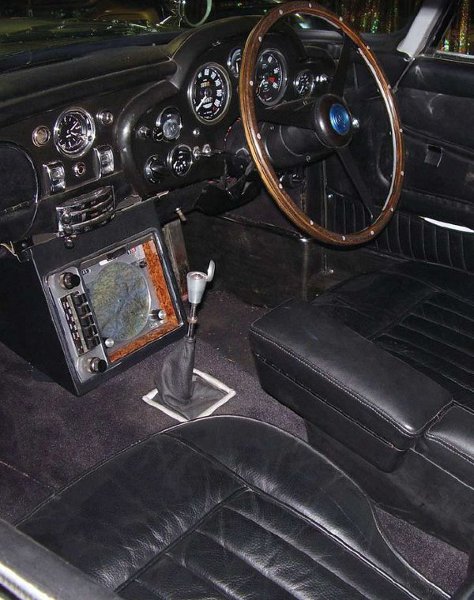
The gear knob triggered an ejector seat, there was an early GPS tracking monitor, weapons tray, front-firing machine guns, mud slick, rear bulletproof screen and more.
PETROL HEADS UNITE!
It was a different story when I was making a TV series called The Saint. We thought it would be rather good if Simon Templar drove a British Jaguar car and our production manager, Johnny Goodman, duly approached them about a twenty-six-part primetime TV show. ‘Oh, and we need three … next week.’
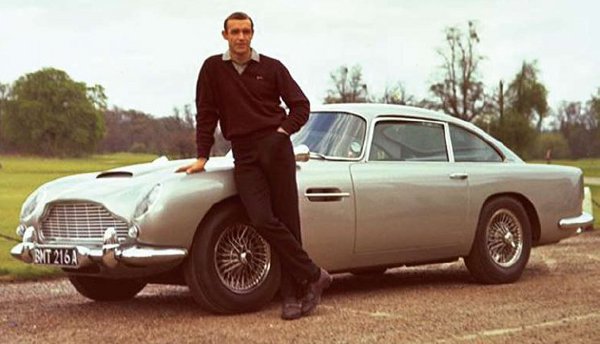
It wasn’t really until Goldfinger that the ‘Bond car’ really grabbed people’s imagination. The Aston Martin DB5 featured a wealth of optional extras.
They shrugged their shoulders in a rather pompous way. ‘Think of the publicity!’ Johnny exclaimed. They told Johnny they had order books bulging and a waiting list they couldn’t fulfil as it was … ‘Why do we need publicity?’
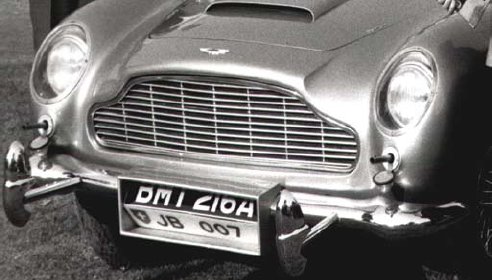
Oh yes, it also had revolving number plates inspired by director Guy Hamilton getting fed up of receiving parking tickets in London.
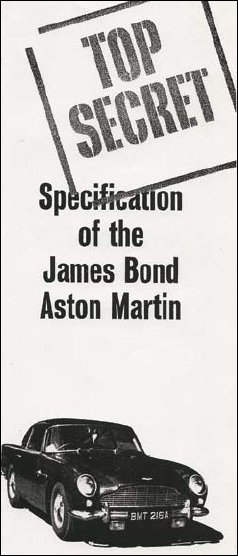
The Bond DB5 even had its own specification booklet.
So we went to Volvo, who couldn’t do enough to help us. Volvo is still going strong … and Jaguar? Well, they’re around.
As 007 I have found myself at the wheel of many modes of vehicular transport; however, as my friend Michael Caine might say ‘not a lot of people know that …’ The Bamford & Martin 1.5-litre Side Valve Short Chassis Tourer was James Bond’s very first car.
According to the first ‘Young Bond’ book, SilverFin, by Charlie Higson, Jimmy inherited the car at the age of thirteen from his uncle Max, and drove it regularly, even though he was underage. The car was destroyed in the third Young Bond novel, Double or Die, leading Bond to replace it with the Bentley Mark IV – as later featured in Fleming’s novels, although petrol heads among you will know there has never been a Bentley model known as the ‘Mark IV’. That appellation was a creation of Ian Fleming, and erroneously perpetuated ever since.
James Bond’s car in the Ian Fleming novels was a grey 1933 Bentley convertible – featuring a 4.5-litre engine with the Amherst Villiers supercharger. Unlike in the films, no gadgets were ever installed in the cars Bond used in Fleming’s novels. The only armament mentioned at all was a .45 Colt Army Special revolver that Jim kept in the glove compartment.
The Bentley was actually the very first Bond car seen in the film series, shown briefly during From Russia With Love in the scene with Jimmy and Sylvia Trench alongside the River Thames. It featured the added extra of a car phone, which in 1963 was – like many other Bond gadgets – a prototype for future developments.
In Goldfinger Bond asks about his Bentley in Q-Branch, only to be told that it has ‘had its day’ and is instead presented with an Aston Martin DB5 – perhaps the car most famously associated with the entire 007 series. To date the model has featured in five films – Goldfinger, Thunderball, GoldenEye, Tomorrow Never Dies and Casino Royale. I’m told it was also due to feature in The World Is Not Enough, but the shots of it being driven were cut. The 2006 reboot of the series showed Bond winning it in a game of poker in the Bahamas – without any special extras.
DB OR NOT DB?
Though I never drove an Aston Martin as Bond, I did drive a DB5 in the comedy film The Cannonball Run, and a DBS in The Persuaders!. The DB5 also popped up in the TV film The Return of the Man from U.N.C.L.E., with George Lazenby playing a character called ‘JB’.
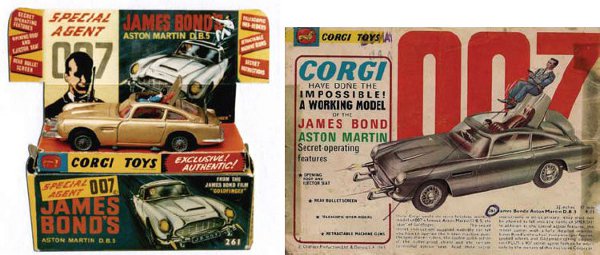
Corgi launched its most successful ever film tie-in model with the DB5 and has since sold over seven million units.
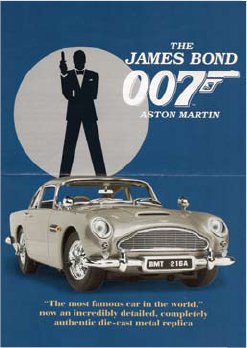
And it still sells today!
The DB5 car as used in Goldfinger and Thunderball was the prototype model, with another standard car (later modified) used for stunts. Both cars were loaned to Eon Productions for the duration of filmmaking and later for publicity tours. Two further cars were later purchased and ‘adapted’ for promotional use through to the late 1960s, one of which sold in 2006 for $2,090,000 (approximately £1.4 million); the second is in the Louwman Collection Museum in the Netherlands. The original gadget car, meanwhile, was stripped of its accessories and sold as a standard car, only to be retrofitted by the purchaser. It was mysteriously stolen in 1997 and has never been found. The second ‘original’ DB5 was sold in 2010, for £2.6 million.
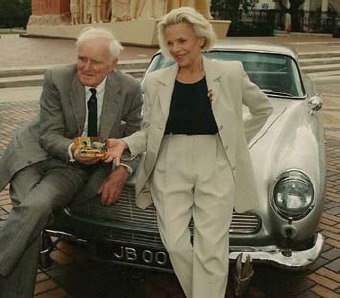
Desmond Llewelyn and Honor Blackman at the launch of the new Corgi range of Bond models in the mid-1990s.
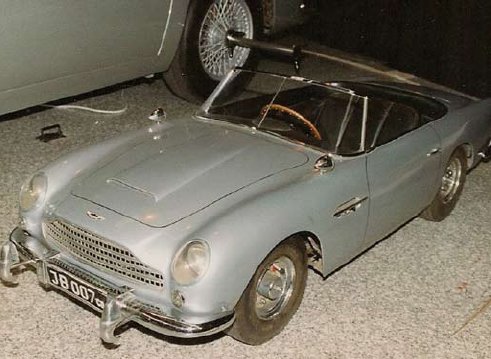
Prince Andrew was given a fully operational scale model of a DB5 for his sixth birthday.
The famous scene in which Q demonstrates all the car’s gadgets to Bond was not originally in the script. Desmond finished his day’s filming and returned home. Cubby called him. He’d been thinking: demonstrating the gadgets to Bond would surely heighten the audience’s excitement to see them in action. As the set was still in place, would Desmond come in for a second day of filming?
Gadgets fitted for Goldfinger include …
 Front-firing Browning .30-calibre machine guns behind the front indicators
Front-firing Browning .30-calibre machine guns behind the front indicators
 Retractable tyre-slashing blades concealed in the rear wheel hub caps
Retractable tyre-slashing blades concealed in the rear wheel hub caps
 Radio telephone in the driver’s door panel
Radio telephone in the driver’s door panel
 Radar scanner and tracking screen hidden behind car radio speaker
Radar scanner and tracking screen hidden behind car radio speaker
 Passenger ejector seat
Passenger ejector seat
 Oil slick spray hidden within rear light cluster
Oil slick spray hidden within rear light cluster
 Caltrop ejector device hidden within rear light cluster
Caltrop ejector device hidden within rear light cluster
 Smoke screen from exhaust pipes
Smoke screen from exhaust pipes
 Front and rear extending rams
Front and rear extending rams
 Gun cabinet under driver’s seat
Gun cabinet under driver’s seat
 Bulletproof windscreen and rising bulletproof rear screen
Bulletproof windscreen and rising bulletproof rear screen
 Revolving number plates, valid all countries, naturally:
Revolving number plates, valid all countries, naturally:
BMT 216A (UK) 4711-EA-62 (France) LU 6789 (Switzerland)
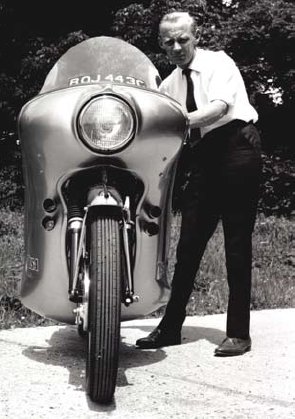
Special-effects engineer Bert Luxford with his adapted BSA motorcycle for Thunderball.
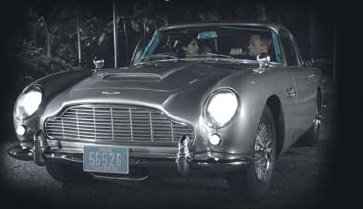
The DB5 returns in Casino Royale.
Other Astons featured in the series include:
 A DBS was used in the pre-credits and closing scenes of On Her Majesty’s Secret Service as Jim and Tracy’s wedding car. It was glimpsed in the subsequent film, Diamonds Are Forever, parked up in Q-Branch.
A DBS was used in the pre-credits and closing scenes of On Her Majesty’s Secret Service as Jim and Tracy’s wedding car. It was glimpsed in the subsequent film, Diamonds Are Forever, parked up in Q-Branch.
 In The Living Daylights Timothy Dalton drove a V8 Vantage Volante convertible and its hardtop version. All the usual refinements were in place, including extending side outriggers, spike-producing tyres, missiles, lasers, signal-intercepting smart radio, head-up display and rocket propulsion. It could also self-destruct when primed. Doesn’t every car?
In The Living Daylights Timothy Dalton drove a V8 Vantage Volante convertible and its hardtop version. All the usual refinements were in place, including extending side outriggers, spike-producing tyres, missiles, lasers, signal-intercepting smart radio, head-up display and rocket propulsion. It could also self-destruct when primed. Doesn’t every car?
 Pierce Brosnan’s first outing as 007 – GoldenEye – brought back the Aston Martin DB5 and this time pitted it against a Ferrari in the hills above Monte Carlo; while in his last outing, Die Another Day, the Aston Martin V12 Vanquish (or ‘Vanish’) was introduced by the new Q. It featured front-firing rockets, hood-mounted target-seeking guns, spike-producing tyres and a passenger ejector seat in homage to the original Aston Martin DB5. This Aston was also equipped with ‘adaptive camouflage’ – a cloaking device that allowed it to become effectively invisible at the push of a button. Hmmmm. A little far-fetched even for Bond!
Pierce Brosnan’s first outing as 007 – GoldenEye – brought back the Aston Martin DB5 and this time pitted it against a Ferrari in the hills above Monte Carlo; while in his last outing, Die Another Day, the Aston Martin V12 Vanquish (or ‘Vanish’) was introduced by the new Q. It featured front-firing rockets, hood-mounted target-seeking guns, spike-producing tyres and a passenger ejector seat in homage to the original Aston Martin DB5. This Aston was also equipped with ‘adaptive camouflage’ – a cloaking device that allowed it to become effectively invisible at the push of a button. Hmmmm. A little far-fetched even for Bond!
 When Casino Royale hit the screens, we saw the new Aston Martin DBS V1 (right) as Jim’s car of choice, although no special gadgets were visible other than the compartments that housed his Walther P99 and an emergency medical kit. It turned up again in Quantum Of Solace and was all but destroyed after a chase in Siena, Italy. Nice to know some things don’t change.
When Casino Royale hit the screens, we saw the new Aston Martin DBS V1 (right) as Jim’s car of choice, although no special gadgets were visible other than the compartments that housed his Walther P99 and an emergency medical kit. It turned up again in Quantum Of Solace and was all but destroyed after a chase in Siena, Italy. Nice to know some things don’t change.
ESPRIT DE CORPS!
My own Bondmobile came in the shape of the Lotus Esprit. The story goes that Donovan McLauchlan, public relations manager at Lotus, had been tipped off that the next Bond movie, The Spy Who Loved Me, was gearing up for pre-production at Pinewood. It was early 1976, and he drove an Esprit to the studios and parked it right in the path of anyone trying to get in or out of the main admin building entrance. It wasn’t long before Cubby saw the car and made a phone call – not to get it towed, but to ask all about it. Their gamble paid off.
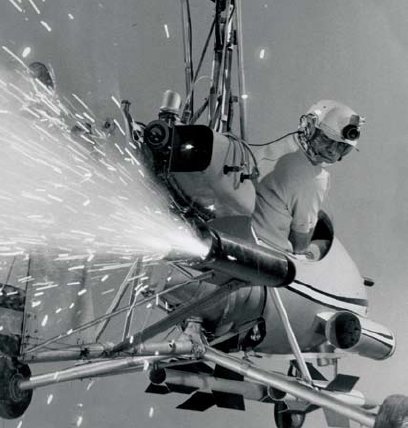
Little Nellie, the autogyro, held her honour against several SPECTRE airborne thugs in You Only Live Twice.
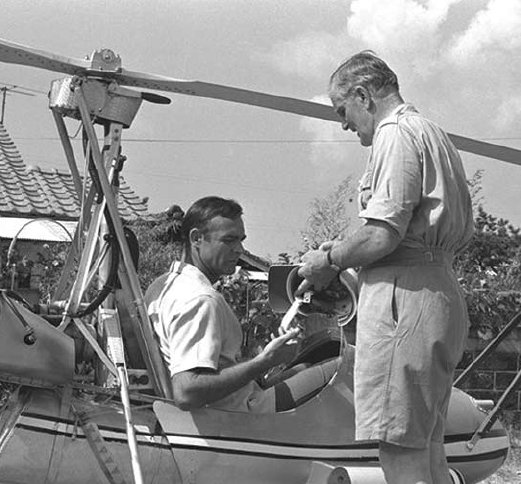
And here is her ‘Uncle’, dear Desmond Llewelyn, describing her operation to 007 – please note he is wearing shorts!
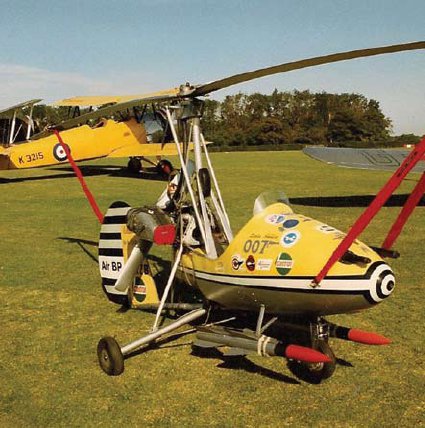
And here she is today, still proudly sporting her 007 weaponry.
Lotus loaned us two production Esprit’s, five Esprit body shells and two Lotus personnel for the shoot. The body shells were used to make the underwater car, as adapted by Perry Oceanographics. A full underwater conversion mode with fins, front-mounted rocket launchers, mines, a periscope, a smoke screen and a surface-to-air missile was pretty exciting. There was also a cement sprayer concealed behind the registration plates.
Other body shells were used in various scenes, including the shot of the Esprit driving off the pier into the sea. That one was powered by compressed air, equipped with a space-frame and locked steering wheel … It’s nice to know no actors were harmed.
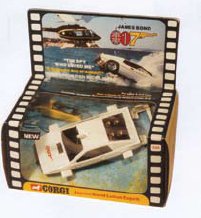
The Corgi model of the Lotus Esprit.
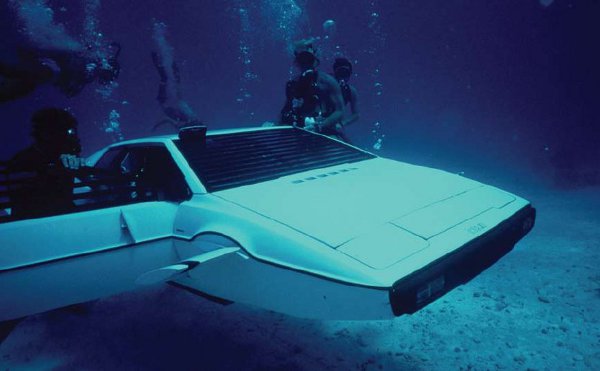
Just popping into the cove for its 6,000-mile service.
Lotus sales increased dramatically after the film’s release, with a three-year waiting list for Esprits in particular. I myself was offered the opportunity to buy one at a ten per cent discount. Needless to say, their overwhelming generosity was not something that particularly excited me.
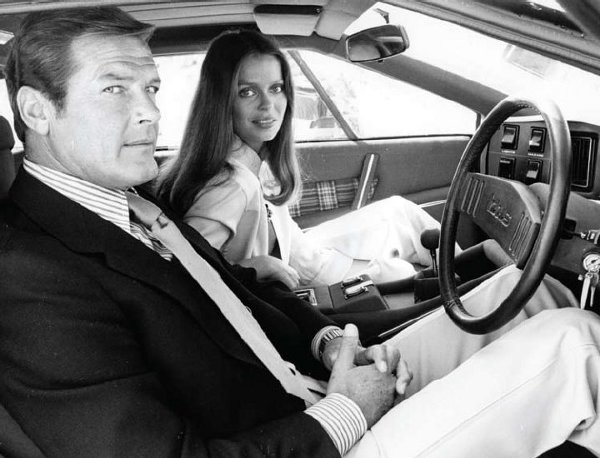
Always room for a pretty passenger in the Lotus Esprit.
The cars were problematic in the extreme. During filming, their engines overheated and batteries ran down quickly. Their low driving position made elegant exits from the car an issue, and all this made the action location in Sardinia a little fraught.
When we heard later that publicist John Willis was due to drive the car from London to the Cannes Film Festival in May 1977, we took bets on whether he’d make it. He did get as far as Lyon without issue, before ending up on the back of a tow truck heading for a local garage. It then limped into Cannes, was positioned outside the Carlton Hotel and duly refused to move again thanks to a flat battery. If only the world’s press could have snapped the team of mechanics at work during the dead of night, it would have made terrific headlines – ‘James Bond’s car breaks down’.
Though the Lotus transformed into a submarine on screen, a combination of miniatures and body shells were used to achieve the effect of the conversion. It could be driven underwater, but only in a full wetsuit, as the interior was not air-locked. Consequently it was dubbed ‘Wet Nellie’.

Cubby really didn’t like my little joke of dropping a fish out of the window when we emerged from the sea. However, when it got more laughs than the scripted version in rushes, he conceded it was one of my better ideas.
The scene where the car emerges from the ocean onto a beach, was shot in two parts: with an Esprit shell being pulled on a tow rope to the point at which the car was to emerge, and then a cut to the real car in the surf. The little toddler who watches the car come out of the water and points is Richard Kiel’s son, RJ. He’s now a thirty-six-year-old doctor.
I thought it might be a giggle to wind down the window and drop a fish out as we drove onto the beach. Cubby wasn’t at all happy, and said we should re-shoot; he felt it was a little too flippant and therefore not funny. I said OK, but when we ran both versions in rushes the next day my prank got a huge laugh. Cubby conceded.
In For Your Eyes Only the Lotus returned, twice. The first one, a white Esprit Turbo, was destroyed when a thug tripped its self-destruct system by breaking the driver’s-side window. The second one, a red version of the same model, was driven by moi in Northern Italy, though you didn’t get to see many of the gadgets in operation, I’m afraid, as a wonderful scene with John Moreno as Luigi – where he tampered with a few buttons – was unfortunately cut due to time constraints. If you listen carefully, when I leave him in the car to go into the ice rink I tell him not to play with any of the buttons.
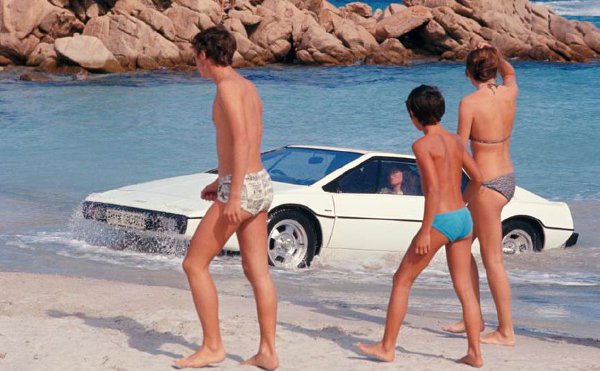
OVER AIR, LAND AND SEA
The wet bike was another brilliant innovation first seen by the public in a Bond movie – again, in For Your Eyes Only. I was given a little time to get used to it on the beach at the Cala di Volpe and, in my bathing trunks, leapt aboard and mastered the controls, swishing around in the surf thinking it was all rather like a jet boat. Then I was told in the scene I’d be wearing full Naval Commander uniform for the ride to Stromberg’s lair, and I had to arrive immaculate and dry, without a hair out of place. OK, I thought, I’ll give it a whirl.
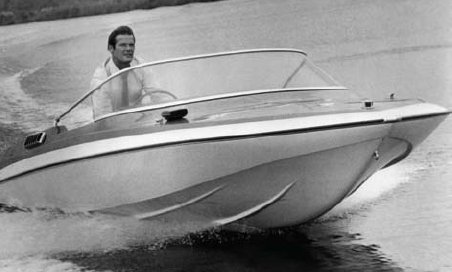
The Glastron boat chase in Live And Let Die was, thankfully, filmed at the beginning of the production schedule. I’d hurt my leg in rehearsals and could happily sit down for my brave introduction as 007.
Fresh from the hair-and-make-up truck, I hopped onto the bike, started her up and made my way out to sea. It was all perfectly fine until I heard the ‘chop-chop-chop’ of the helicopter above, obviously filming. Just then, a huge downdraft created by its rotors took hold and started pushing the bike down into the sea. I had no way of contacting either the helicopter or the boat behind, but knew if I fell in it would mean a complete wardrobe change, hair, make-up, the lot – and that would take a very long time. More by steely determination and grit than anything else I managed to keep the bike going at no more than a forty-five-degree angle to the surface. Sometimes being brave is pretty tough going.
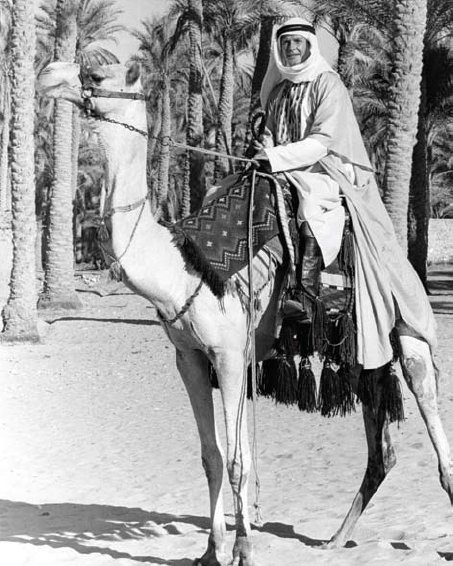
Not the most gadget-packed of Bond vehicles … I think he got the hump with me.
As well as kitting Bond out with the best thing on four wheels, the writers sometimes turn an idea on its head and say, ‘Let’s try him in a …’ Well, if a Lotus is one of the most powerful cars, the direct opposite would be a Citroën 2CV, with its mere two-horsepower engine, yet another vehicle that featured in For Your Eyes Only. It was huge fun to drive down through olive groves in – it just goes to show, it’s more about the driver’s skill than it is the size of his engine, or so the Bond girls say.
But what on earth could be even less powerful than a 2CV? How about an Indian Tuk-Tuk motorized rickshaw? With the pull of a lawnmower engine, and manoeuvrability of same, it was used to great effect in Octopussy as an escape vehicle.
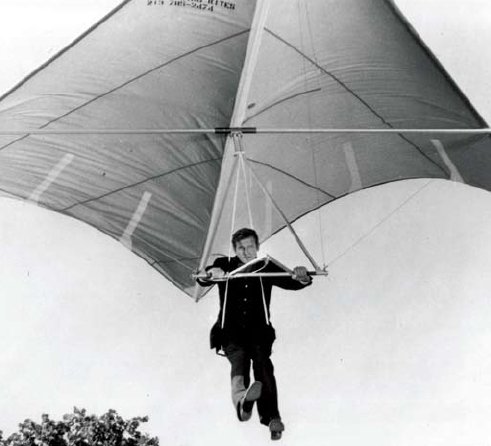
By land, by sea and then by air … if I’m not mistaken it was the first time we saw Jimmy hang-glide into the villain’s lair. I was so brave.
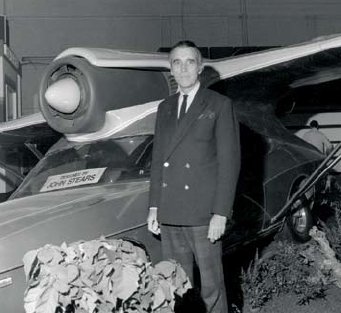
In The Man With The Golden Gun it wasn’t just Jimmy who had a gadget car. Villain Scaramanga (Christopher Lee) owned a Matador Coupé, which converted into a flying car.
Oh, and I shouldn’t forget the ‘Bondola’ from Moonraker. That was all rather tongue-in-cheek, but why wouldn’t Jim have a supercharged gondola? Filming in Venice is never particularly easy, especially with the vast crowds looking on, but shooting around the canals was fairly straightforward as there was nowhere for people to watch – aside from a few bridges – and it all happened so fast, they didn’t really know what it was all about anyway as we were there under stealth.
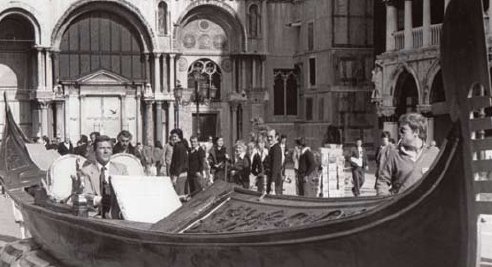
The tipping Bondola from Moonraker. Lucky I had my little hooter to warn passersby to move out of the way.
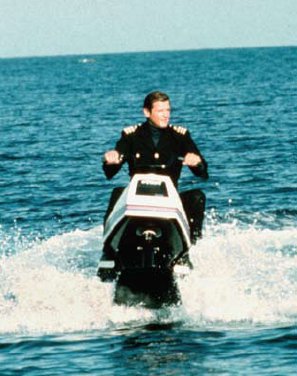
Don’t fall off! I knew if I did I’d face a two-mile trip back to shore for make-up, hair and new costume.
Once we reached St Mark’s Square for the scene where the gondola converts into a hovercraft, however, we were confronted with 20,000–30,000 tourists, largely Oriental, all armed with Nikon cameras.
There were two gondolas used in the sequence: the first inflated and raised out of the water, then we cut to a second on land, which was built around a Ford chassis. I arrived in my lovely light-grey silk suit for the first take, sat in the boat and the air was switched on – but seemingly only on one side, thus toppling me out and straight into the Grand Canal. Cue much laughter and snapping of Nikons. I trotted off to dry, change, have my hair and make-up done and, thirty minutes later, returned.
‘Action!’ called Lewis, and I was tipped sideways into the canal yet again. This happened on five takes, where one side inflated faster than the other, tipping me in each time. Each time, the laughter increased, as did the size of the crowds gathered. Take 6 – and my final dry suit. Thankfully, it worked and we wrapped for the day.
Next morning, I hopped inside the Ford-chassis gondola to drive it right the way across the square, which by then was starting to fill with tourists. Rather than attempt to control the crowds, Lewis said we’d just shoot, as they really wouldn’t know what we were doing until it was over.
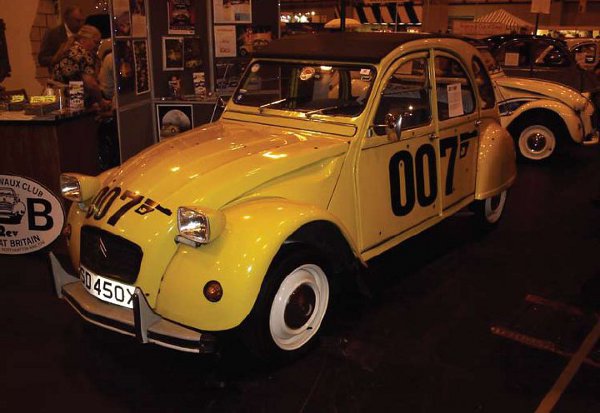
From the sublime to the ridiculous, a two-horsepower getaway vehicle in For Your Eyes Only.
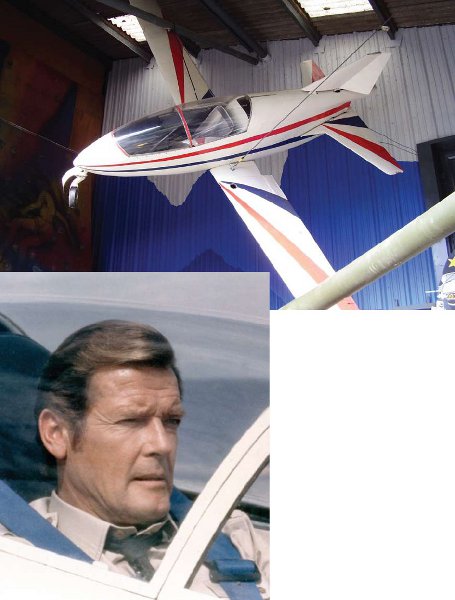
The Octopussy Bede Jet folded up into a horse trailer, and could just about accomodate a 6’ 2’’ Bond.
‘Fair enough,’ I said. ‘But I really do feel I need some sort of horn to warn people that there is a motorized gondola approaching them, driven by an English actor, on St Mark’s Square as it’s not something they’d really expect.’ They found some sort of claxon, and I literally beep-beeped my way around unsuspecting tourists, across to a sharp right turn down a narrow road. It was so narrow the F/X boys put Vaseline down the side of the gondola so I could slip down more easily.
Then of course in Live And Let Die I took it to another extreme when I drove an AEC Regent RT-type double-decker bus. I remember that day well: it was 7 December 1972, on location in Montego Bay, Jamaica, and I had to drive it under a low bridge, sheering off the top deck. Maurice Patchett from London Transport’s Chiswick depot spent three months preparing for the stunt, including taking me on a crash course – forgive the pun – on the Chiswick skid pad. Maurice took over the driving as the bus headed for the bridge; the top deck had been carefully removed and replaced only on rollers, to ensure a relatively clean detachment as it hit at precisely 30 mph.
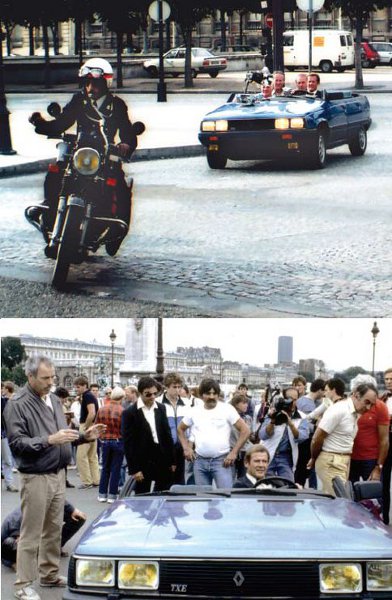
On location in Paris for A View To A Kill, I had to drive and virtually destroy a Renault taxi in my pursuit of Mayday. I guess it beats having to tip a driver.
Maurice said that if the film game didn’t work out for me, I’d make a good London bus man. That would have pleased my mum, who still lived in hope I might one day get a proper job.
I also chopped the top of a car off in a film – a Renault 11 taxi in fact – in the Parisian scenes of A View To A Kill, while trying to chase Grace Jones. Wish I hadn’t bothered trying, actually. Nevertheless, that was a terrific sequence, all very carefully orchestrated by the superb Remy Julienne. Alas, these days when visiting Paris I have to sit in the traffic just like everyone else.
In my last 007 outing, I found myself at the controls of a San Francisco fire truck. When I heard we were going to be shooting in the city, I thought, ‘Oh, here we go, another attempt at bettering Bullit with Steve McQueen,’ but when they told me my mode of transport would be somewhat different, I was intrigued. It certainly cleared the traffic off the roads.
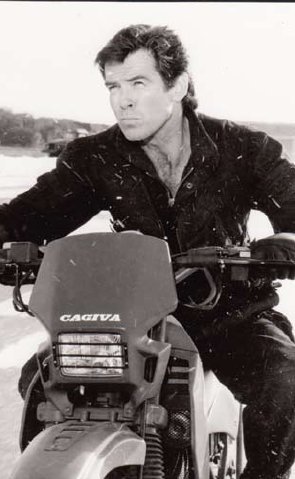
The opening of GoldenEye saw new 007 Pierce Brosnan chase a plane down a runway on a motorbike. As you do.
And just to prove Q didn’t exclusively think of the 00 section in his work, he designed himself a fishing boat – for his retirement. The Q-boat came equipped with submersible capabilities, torpedoes, rocket booster and GPS tracking, though Q was keen to point out it was not properly finished when Jim took off in it during The World Is Not Enough.
THE CLASSIC STUNT
I can’t end any discussion of Bond cars and assorted vehicles without mentioning the AMC Hornet, can I? The what? Well, if I was to say when Jim is chasing Mary Goodnight in The Man With The Golden Gun, he steals a car in which Sheriff J.W. Pepper is about to take a test drive, you’ll be with me. During the chase, Jim makes a corkscrew jump over a river. That wasn’t just lucky guesswork, but the first case of a computer designing a stunt. Race car driver Jay Milligan, who promoted the American Thrill Show during the 1960s and 1970s, first performed the stunt, known as the Astro Spiral Jump, on 12 January 1972 at the Houston Astrodome. Always keen to hear about anything a bit unusual or daring, Cubby was soon told about the stunt everyone was talking about, and put a call through to Milligan.
Researchers at Cornell University for the National Highway Traffic Safety Administration did a computer simulation of the stunt to calculate the exact angles required, speeds to drive and so forth. These details were passed over to the production team, and the bridge was erected.
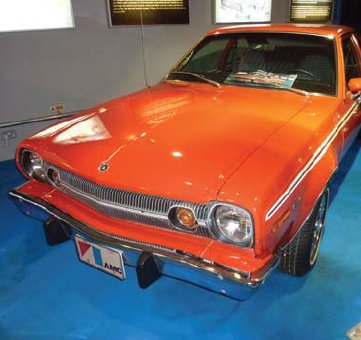
The AMC Hornet that performed the amazing 360-degree roll in The Man With The Golden Gun.
With Milligan supervising, the 360-degree spiral was shot in just one take, with British stuntman ‘Bumps’ Williard at the wheel and with eight cameras simultaneously capturing the action. Meanwhile divers, ambulances and cranes were on standby in case of any unforeseen consequences. The jump was over in a second and to achieve greater screen time is shown in slow motion. Williard was given a large bonus for completing it on the first take, by the way.
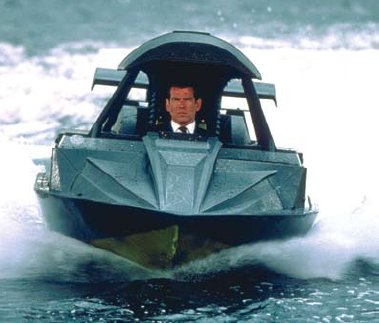
When Q retired, he envisaged a life of fishing. So he built himself a fishing boat – albeit with missiles, GPS and other gadgets. Perhaps to help land those big catches?
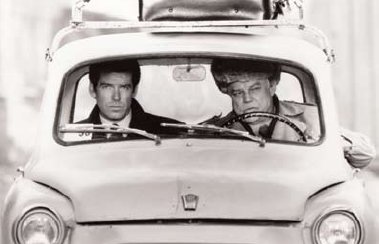
Though sometimes, when a BMW or Aston is not available, a smaller mode of transport will suffice.
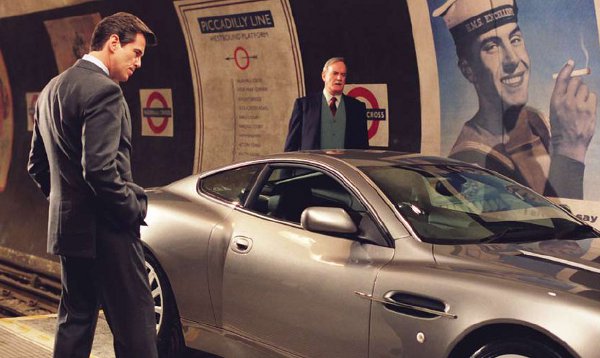
With Die Another Day the Aston Martin was back, in the shape of the Vanquish – or Vanish, as 007 dubbed it.
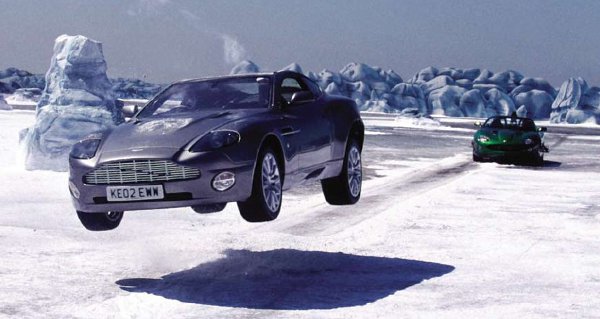
And here is the Vanquish in action!
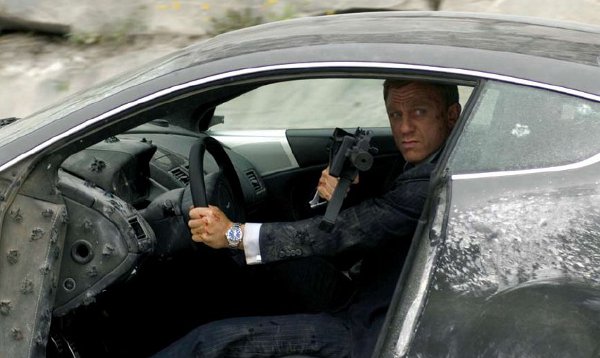
With Daniel Craig, a new Aston Martin was introduced – the DB9. Something tells me he’ll have to go for the expensive valeting option.